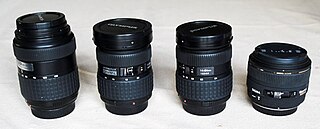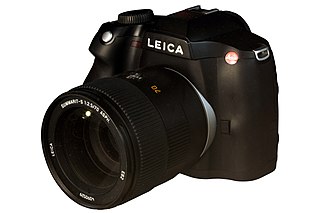Related Research Articles

A digital camera is a camera that captures photographs in digital memory. Most cameras produced today are digital, largely replacing those that capture images on photographic film. Digital cameras are now widely incorporated into mobile devices like smartphones with the same or more capabilities and features of dedicated cameras. While there are still dedicated digital cameras, many more cameras are now incorporated into mobile devices like smartphones. High-end, high-definition dedicated cameras are still commonly used by professionals and those who desire to take higher-quality photographs.

A system on a chip is an integrated circuit that integrates all or most components of a computer or other electronic system. These components almost always include a central processing unit (CPU), memory, input/output ports and secondary storage, often alongside other components such as radio modems and a graphics processing unit (GPU) – all on a single substrate or microchip. It may contain digital, analog, mixed-signal, and often radio frequency signal processing functions.

Pentax is a brand name used primarily by the Japanese multinational imaging and electronics company Ricoh for DSLR cameras, lenses, sport optics, and CCTV optics. The Pentax brand is also used by Hoya Corporation for medical products & services, TI Asahi for surveying instruments, and Seiko Optical Products for certain optical lenses.
JTAG is an industry standard for verifying designs and testing printed circuit boards after manufacture.

A digital single-lens reflex camera is a digital camera that combines the optics and the mechanisms of a single-lens reflex camera with a digital imaging sensor.

Advanced Photo System type-C (APS-C) is an image sensor format approximately equivalent in size to the Advanced Photo System film negative in its C ("Classic") format, of 25.1×16.7 mm, an aspect ratio of 3:2 and Ø 31.15 mm field diameter. It is therefore also equivalent in size to the Super 35 motion picture film format, which has the dimensions of 24.89 mm × 18.66 mm and Ø 31.11 mm field diameter.
In photography, through-the-lens (TTL) metering refers to a feature of cameras whereby the intensity of light reflected from the scene is measured through the lens; as opposed to using a separate metering window or external hand-held light meter. In some cameras various TTL metering modes can be selected. This information can then be used to set the optimal film or image sensor exposure, it can also be used to control the amount of light emitted by a flash unit connected to the camera.

The Fujitsu FR-V is one of the very few processors ever able to process both a very long instruction word (VLIW) and vector processor instructions at the same time, increasing throughput with high parallel computing while increasing performance per watt and hardware efficiency. The family was presented in 1999. Its design was influenced by the VPP500/5000 models of the Fujitsu VP/2000 vector processor supercomputer line.
Atmel ARM-based processors are microcontrollers and microprocessors integrated circuits, by Microchip Technology, that are based on various 32-bit ARM processor cores, with in-house designed peripherals and tool support.

PSoC is a family of microcontroller integrated circuits by Cypress Semiconductor. These chips include a CPU core and mixed-signal arrays of configurable integrated analog and digital peripherals.
A multiprocessor system on a chip is a system on a chip (SoC) which includes multiple microprocessors. As such, it is a multi-core system on a chip.

An image processor, also known as an image processing engine, image processing unit (IPU), or image signal processor (ISP), is a type of media processor or specialized digital signal processor (DSP) used for image processing, in digital cameras or other devices. Image processors often employ parallel computing even with SIMD or MIMD technologies to increase speed and efficiency. The digital image processing engine can perform a range of tasks. To increase the system integration on embedded devices, often it is a system on a chip with multi-core processor architecture.

This article is about photographic lenses for single-lens reflex film cameras (SLRs) and digital single-lens reflex cameras (DSLRs). Emphasis is on modern lenses for 35 mm film SLRs and for DSLRs with sensor sizes less than or equal to 35 mm ("full-frame").
BIONZ is a line of image processors used in Sony digital cameras.

The Leica S2 is a digital medium format DSLR camera announced by Leica Camera on September 23, 2008.

A mirrorless interchangeable-lens camera (MILC) or simply mirrorless camera, also called digital single-lens mirrorless (DSLM) or electronic viewfinder interchangeable lens (EVIL) camera, is a photo camera featuring a single, removable lens and a digital display. The camera does not have a reflex mirror or optical viewfinder like a digital single-lens reflex (DSLR) camera. Many mirrorless cameras retain a mechanical shutter. Like a DSLR, a mirrorless camera accepts any of a series of interchangeable lenses compatible with its lens mount.

The Nikon Expeed image/video processors are media processors for Nikon's digital cameras. They perform a large number of tasks: Bayer filtering, demosaicing, image sensor corrections/dark-frame subtraction, image noise reduction, image sharpening, image scaling, gamma correction, image enhancement/Active D-Lighting, colorspace conversion, chroma subsampling, framerate conversion, lens distortion/chromatic aberration correction, image compression/JPEG encoding, video compression, display/video interface driving, digital image editing, face detection, audio processing/compression/encoding and computer data storage/data transmission.
The Fujitsu FR is a 32-bit RISC processor family. New variants include a floating point unit and partly video input analog-to-digital converter and digital signal processor. It is supported by Softune, GNU Compiler Collection and other integrated development environments.
The Leica S-System is a medium format digital single lens reflex camera system introduced by Leica Camera in 1996. Beginning with the Leica S1, a prototype top-end studio digital camera unveiled at Photokina 1996. It went into production at the end of 1997.
References
- ↑ Fujitsu: Milbeaut Imaging Processors
- ↑ "Fujitsu: Image processing system for digital cameras: Milbeaut M-4" (PDF). Archived from the original (PDF) on 2015-09-24. Retrieved 2012-12-26.
- ↑ Fujitsu Microelectronics-Leica's Image Processing System Solution For High-End DSLR
- ↑ Pentax hack: Hardware info
- ↑ Sigmauser: TRUE Strengths. Written by Stuart Dennison
- ↑ "Fujitsu Releases New Milbeaut® Image Processor" (Press release). Fujitsu. September 4, 2013. Archived from the original on June 27, 2014. Retrieved March 30, 2014.